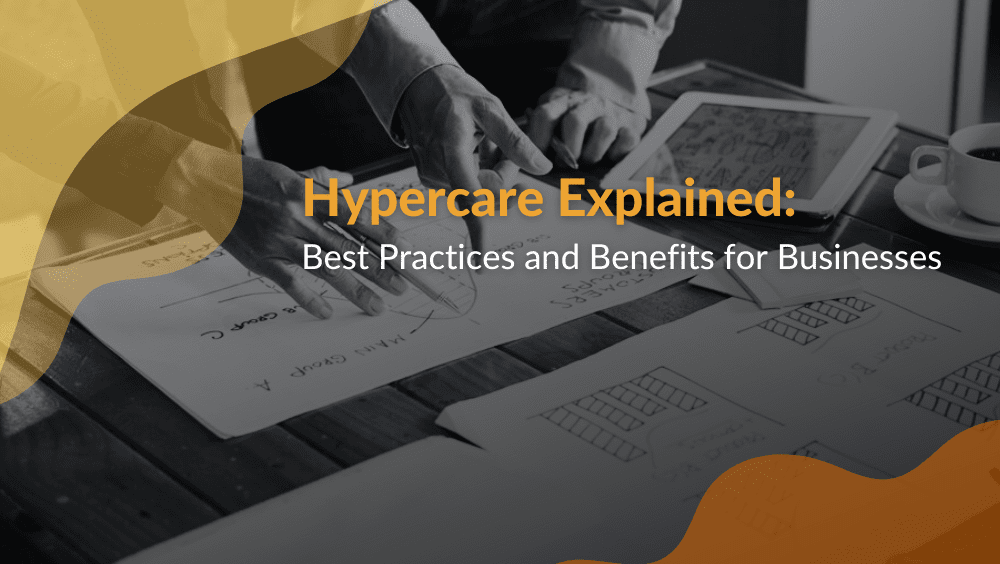No matter the industry, providing exceptional customer service during critical phases like software launches or system changes has become crucial. This is where Hypercare comes in.
Hypercare refers to a period of high-touch support designed to address potential issues proactively. Eventually, this will ensure smooth service delivery and prevent operational disruptions.
What is Hypercare?
Hypercare is the phase of post-launch or post-implementation support provided to ensure the stability of new systems, platforms, or processes. It is an intense focus on customer care, involving continuous monitoring, and immediate resolution of issues. This will ensure the customer or client will have a seamless experience after a significant change.
What is the Hypercare environment like?
In this environment, teams remain on high alert to respond to any concerns swiftly. The goal is to mitigate risks, handle potential bottlenecks, and provide guidance through the initial stages of change or deployment. This high-touch service is critical in industries that rely on complex systems where downtime could result in significant losses or customer dissatisfaction.
Best Practices for Implementing Hypercare

Companies need to integrate both human-centric and technology-driven strategies. These best practices can help streamline the process:
Personalized and Proactive Communication
Personalized communication plays a vital role during the Hypercare phase. Much like high-touch customer service, communication in Hypercare should be tailored to individual customer needs. Each interaction should provide meaningful and relevant information that is timely and specific to their experience. This level of personalization ensures customers feel heard and understood, reducing confusion or frustration.
The key here is to anticipate customer issues before they arise. Continuous monitoring and proactive updates ensure that customers are never left wondering about the status of a service or product.
Empowering Frontline Employees
Since teams are the ones directly interacting with customers, they should be equipped with the necessary tools to resolve issues in real-time. They need full access to customer data, systems, and decision-making authority to fix problems promptly without escalating everything up the chain of command.
Just like in high-touch customer service, frontline employees should be trained not only on technical tools but also on soft skills, ensuring they can maintain customer relationships and manage crises with confidence.
Leveraging Technology for Efficiency
Although Hypercare involves a high level of personal attention, technology can play a significant supporting role. Businesses need to take advantage of CRM systems to track customer interactions and flag issues that need immediate attention. Automated systems can be set up to monitor performance metrics, ensuring any anomalies are identified early.
Additionally, chatbots and automated help systems can address routine customer queries. This frees up human agents to focus on more complex problems.
Continuous Monitoring and Feedback
During Hypercare, businesses prioritize continuous monitoring of system performance and customer feedback. Monitoring systems can identify performance issues such as slow load times, broken functionalities, or inconsistent behavior before customers even notice them. Coupled with proactive feedback collection, businesses can resolve issues in real-time and improve the customer experience during these critical phases.
Gathering customer feedback after every interaction, as seen in high-touch service models, is an excellent way to measure satisfaction and ensure that customers feel supported throughout the Hypercare period.
Common Confusions About Hypercare
While Hypercare sounds straightforward, businesses can often misinterpret its scope. Here are a few common misconceptions:
Hypercare is not a permanent service: It is a time-limited phase, usually lasting anywhere from a few weeks to a few months post-implementation. The goal is to offer heightened support only during the initial phase of a major transition.
It’s more than just customer support: Hypercare is not just about reacting to issues as they arise. It involves proactive measures such as monitoring systems, anticipating risks, and implementing solutions before problems can affect end-users.
Hypercare does not replace continuous support: Once the Hypercare period is over, regular support mechanisms should be in place. Hypercare is intended to stabilize the system, but businesses must continue delivering consistent support post-Hypercare.
Hypercare is not without its challenges
Setting up Hypercare can still be tricky for businesses. Here are some concerns that businesses can expect:
Resource Allocation and Fatigue: Hypercare requires dedicated teams to monitor and support systems around the clock. This can lead to overworking and resource strain, especially if the duration of the Hypercare phase is extended beyond initial expectations. Managing the balance between providing intensive support and avoiding burnout for the teams involved is a significant challenge.
Miscommunication Between Teams: Hypercare phases often involve multiple teams—IT, customer service, and operations—working together to ensure seamless service. Miscommunication or delays in coordination can slow down issue resolution, potentially causing disruptions to service. Ensuring that all teams are aligned and have access to real-time data is critical but can be difficult to manage.
High Costs and Temporary Nature: While Hypercare ensures smoother transitions, it can be expensive due to the need for extra staffing, monitoring tools, and extended hours. Additionally, because it’s a temporary phase, businesses must weigh the cost against the benefits, especially if Hypercare extends longer than planned.
Addressing these challenges requires careful planning, robust communication, and a focus on team well-being to ensure Hypercare is both effective and sustainable.

Benefits of Adopting a Hypercare Approach
The Hypercare approach offers several advantages to businesses that implement it properly:
Increased Customer Satisfaction
It is vital to have personalized, immediate, and proactive support during crucial times. After all, the goal is to ensure greater customer satisfaction, and for customers to feel valued. The Hypercare approach reduces frustration and ensures their loyalty.
Reduced Downtime and Issues
Since Hypercare involves continuous monitoring, businesses can identify and address system issues early, minimizing disruptions and operational downtime.
Higher Customer Retention
By resolving issues before they become significant problems and offering a high-touch experience, businesses can retain more customers. Satisfied customers are more likely to stay loyal to brands that provide them with seamless, stress-free experiences during transitions.
Stronger Customer Relationships
The direct and attentive communication that is part of Hypercare builds trust with clients. By ensuring that customers receive ongoing support during high-risk periods, businesses can solidify long-term relationships.
The best Hypercare approach is possible with KamelBPO
Businesses know that it’s important to integrate personalized, high-touch service with proactive monitoring and technological support. In addition, empowering employees, leveraging technology, and maintaining continuous engagement will ensure a smooth transition during critical phases of their operations.
Hypercare is not just a safety net but an opportunity to strengthen customer relationships, reduce operational risks, and increase overall satisfaction.
KamelBPO is one with different organizations to achieve a successful Hypercare plan. Contact us today to learn more about how we can execute it!

